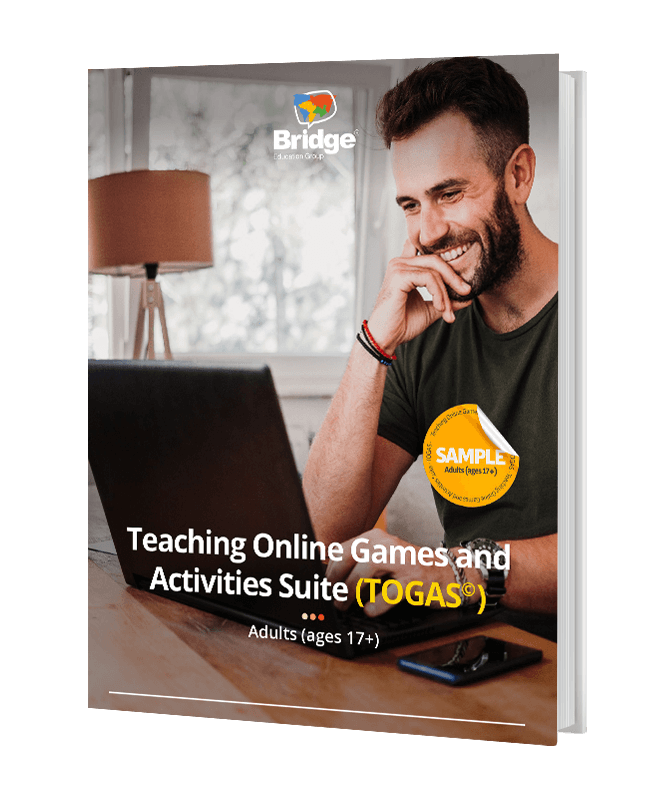More and more TEFL/TESOL educators are finding themselves teaching conversational English as the demand for classes focused on speaking and fluency continues to grow. But, what exactly does it mean to teach English conversation? Are these classes solely focused on free talk? In actuality, conversation classes require preparation and structure just like any other type of ESL/EFL class, but what’s more, they also require perhaps a greater degree of adaptability and “thinking on your feet” than other types of classes. Let’s take a closer look at what goes into English conversation classes, where you can find these types of TEFL/TESOL jobs, and some strategies to help your classes run smoothly.
If you’re new to teaching, you’ll want to get initial training and qualification with a TEFL certificate. You can explore our online TEFL courses to get started!
- What is conversational English?
- What types of students take conversational English classes?
- What skills do you need for teaching conversational English?
- Where can I teach conversational English online?
- What are some tips for teaching English conversation?
- 1. Prepare a list of discussion topics ahead of time.
- 2. Be comfortable with silence.
- 3. Prioritize student talking time (STT).
- 4. Ask open-ended questions.
- 5. Evaluate your own speech.
- 6. Take notes.
- 7. Use a whiteboard or other visual aid.
- 8. Don’t be afraid to incorporate TEFL activities.
- 9. Assign homework.
- 10. Be flexible!
What is conversational English?
At its core, this type of lesson involves teaching English through the art of conversation. You will spend the majority – if not the entire – lesson having a dialogue with your student.
As mentioned earlier, TEFL conversation lessons focus almost solely on speaking skills. Additionally, many conversational English teachers tend to prioritize fluency over accuracy (i.e., the goal is for the student to be understood, not for them to have perfect grammar), but there might be some cases in which students ask for their instructor to pay special attention to accuracy and grammatical errors as well. It really just depends on the individual student’s goals, which you should learn about when conducting your initial student needs assessment.
Modernize your teaching skills to prepare learners for the future with
Micro-credentials in 21st-Century Teaching Skills
Get CertifiedWhat types of students take conversational English classes?
The short answer is all types! Since the primary objective of English conversation classes is to help students practice for real-world conversations they might encounter and to become more confident in their speaking abilities, this type of class is useful for students with a myriad of goals and backgrounds.
For example, you might teach teens who want to practice their ability to orally respond to English questions in order to practice for an upcoming English proficiency exam. You could also teach an adult who learned English years ago and simply wants to practice informally in order to hold on to their language skills. Or, you could teach a business executive who works in a company with clients all over the world and who wants to improve their English pronunciation.
While you will occasionally find group classes, the vast majority of opportunities in this TEFL niche focus on teaching English conversation to students one-on-one. You’ll also notice that most students have at least some experience with the English language, as it’s rare for absolute beginners to seek out conversation classes since they wouldn’t have the basic vocabulary they’d need to sustain a conversation. It’s also far more likely that you’ll be teaching teens or adults, as it might be difficult for a very young learner to sit and converse for an hour or more at a time (because of their attention span).
Check out these speaking activities you can use to help students improve their English!

What skills do you need for teaching conversational English?
In addition to all of the general English teaching skills (like lesson planning, familiarity with different ELT methodologies, etc.) you acquire in your TEFL certification course, conversational English teachers need to have some additional qualities:
- People Skills – Speaking is perhaps one of the skills that intimidates students the most when learning a new language. To encourage students to speak up, you’ll need to be able to make them feel at ease when talking to you. Pay special attention to building rapport with your students and creating an environment in which they feel comfortable sharing their thoughts and speaking (and making English mistakes).
- Conversational Skills – In order to improve your student’s English speaking skills through conversation, you, of course, need to excel as a conversationalist. This means being able to actively listen, being able to convey your ideas clearly, speaking at an agreeable speed, having strong pronunciation skills, being able to show comprehension and ask for clarification, and being able to check the listener’s understanding. It also means that you intuitively understand the ebb and flow of a good conversation and that you know when and how to seamlessly shift topics.
- Nonverbal Communication Skills – A lot of communication occurs nonverbally, and whether you are teaching conversational English online or in person, you’ll need to ensure that you are adept at conveying information through posture, gestures, facial expressions, and other nonverbal cues. This is especially important when it comes to listening to your students speak and helping them to feel confident while doing so.
- Improvisation Skills – You never know exactly where a conversation might take you, and even if you have planned a list of topics to discuss during an hour-long class, you don’t know what your student is going to say about each one and where the conversation will naturally veer on its own. Conversational English teachers need to be especially good at thinking on their feet and adapting when conversations take turns they weren’t expecting.
Where can I teach conversational English online?
ELT marketplaces
Online English teaching marketplaces, like Preply, are platforms on which teachers can list their services and set their own fees in order to attract students to take their classes. In exchange for bringing students to the platform and handling all financial transactions, the marketplace takes a cut of teachers’ earnings.
ESL conversation classes are so popular that some marketplaces will even provide short articles or other resources to help spark conversations between tutors and students. And, some platforms have features that allow students to call a tutor instantly (rather than scheduling a session), so teachers can be on standby or “active” for spontaneous conversations.
Learn how to stand out on online ELT marketplaces.

Private tutoring
A lot of English teachers who start their own tutoring business end up teaching conversational English online at some point. These types of lessons are just so popular that you’ll come across a lot of students who are looking for them, whether it’s to improve their pronunciation, boost their speaking confidence, expand their vocabulary, or something else entirely.
ESL conversation classes offer a way to improve one’s speaking skills in a relaxed, fun setting, and they are usually shorter in duration (typically, they are 30 minutes to an hour long), so it’s no surprise that these attract so many different types of students.
What are some tips for teaching English conversation?
1. Prepare a list of discussion topics ahead of time.
When it comes down to how to teach English conversation, the most important thing to do is prepare your list of topics ahead of time. The idea isn’t to talk about everything on your list in one class or even to stick exclusively to your chosen topics. Rather, the purpose of a list is to have a conversation starting point and plenty of topics you can pull out of your back pocket if and when the conversation lags. There are many interesting topics to talk about in an ESL/EFL class, as you can incorporate everything from hobbies to news to art – literally, anything!
You can use this list of discussion questions to get started.
2. Be comfortable with silence.
During any English conversation class, there will be times of silence. Many teachers find this uncomfortable at first and feel the need to fill the silence or prompt an answer from their student. Remember that not only is your student trying to come up with an answer to a topic or question they were spontaneously asked about (i.e., they didn’t have access to your topic list ahead of time), but they are also translating into another language. Don’t jump in right away – give them plenty of time to formulate their thoughts and then construct the English phrases needed to convey those thoughts.
3. Prioritize student talking time (STT).
In all classes, but especially in a conversation class, it is important to allow plenty of student talking time (STT) and to reduce teacher talking time (TTT). The whole point of a conversation class is to allow the student to practice speaking English, so be mindful of how much talking you’re doing. The student should always be speaking more than you!
Learn ways to reduce teacher talking time (TTT).

4. Ask open-ended questions.
Open-ended questions are a great way to get students to speak in more complex sentences and offer more information than they would if asked a question with a straightforward answer or a yes/no response. Open-ended questions also pave the way for new topics to come up naturally. For example, if you ask your student, “If you could have your dream job, what would you be doing?” it might just lead down a rabbit hole of discussing a certain industry, hobby, or passion. In particular, opinions and experiences are two areas that provide ample opportunities for open-ended questions.
5. Evaluate your own speech.
Like in any English class, you’ll need to pay special attention to your register (how formally you speak, the level of vocabulary you incorporate, the syntax you choose, etc.) and your speaking speed. You’ll want to speak naturally, so your student can practice English conversation in a realistic setting, but also be mindful of the learner’s English level. You want them to improve their English, not feel lost in the conversation!
6. Take notes.
Taking notes will help you immensely when it comes to error correction, as there are times when you won’t want to correct your student while they are still speaking. Instead, you can refer back to your notes as you’re wrapping up a certain topic or at the end of the class to let a student know what they need to work on grammatically or to clarify a misused vocabulary word.
If you are teaching a specific student regularly (i.e., teaching them more than just once), then taking notes is especially vital so you don’t repeat the same topics in the next ESL conversation class. It can get quite tricky to remember who has already discussed what when you have many students taking conversation classes in a given week!

7. Use a whiteboard or other visual aid.
Though teaching English conversation doesn’t involve a lot of writing, it is still important to be able to show a student what a newly learned word looks like and how it’s spelled. Having a visual is especially nice for helping students with their pronunciation, as you can help them sound out the word. Make sure that you have a physical or digital whiteboard, or at the very least, a chatbox, at your disposal.
8. Don’t be afraid to incorporate TEFL activities.
Just because you are teaching conversational English doesn’t mean you can’t plan fun activities for your classes! Here are just a few ideas to consider:
- Role-plays work particularly well for conversation classes. You could have your student pretend to be in an interview with you, or you could have them practice calling to set up a bank account or make a hotel reservation. Role-plays still count as conversations!
- You can use a topic generator like this one from ConversationStarters.com and take turns asking each other questions using the topics provided.
- You could make the conversation a game by printing out or typing up a list of questions that correspond to certain numbers and rolling dice to see which corresponding question your student has to answer.
- You can incorporate timed activities and have students speak about either a serious or funny topic for a set amount of time.
There are endless possibilities for making conversations more fun!
Build your students' confidence with this free eBook sample
Teaching Online Games and Activities – Adults
download9. Assign homework.
Homework is a great way to have students come prepared to discuss a certain topic for the next class. For example, you can have them read a specific article and be ready to discuss it with you. Or, you can ask them to listen to an episode of a podcast of their choosing and have them come to class and summarize it for you. These are great, authentic ways to spark conversation and also get students practicing English outside of class time.
10. Be flexible!
Teaching conversational English requires flexibility, as you never knew where a conversation will lead. It’s best to let the discussion flow naturally and lean into whatever topics your student seems to be interested in. The more excited they are about a subject, the more likely they are to speak up in class. And, while slightly looser in structure than some traditional types of English classes, the spontaneous nature of conversation classes is partly why they can be so much fun to teach!
Teaching conversational English involves much more than just free talk. It requires a special set of skills, plenty of preparation, and a willingness to be spontaneous. It can, however, be very rewarding and tons of fun, as you’ll get to know a lot about your students on a personal level, as well as see them progress on their English language journey.











